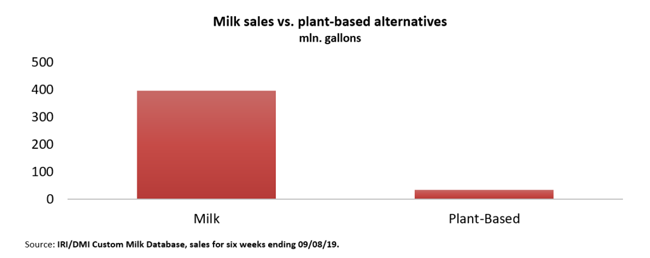
Written by: Guest | January 9, 2020
 Alan Bjerga
Alan Bjerga
Senior Vice President of Communications, National Milk Producers Federation
Among the special days of the holiday season, National Milk Day (January 11, if you haven’t already marked your calendar) may not get the attention Christmas gifts and New Year’s kisses may attract. But the day, believed to be the anniversary of the first delivery of milk in bottles in the U.S. in 1878, is a good occasion to look at where milk stands with consumers and where it’s heading next.
Most people don’t spend much time thinking about milk. It’s easy to take for granted, given that milk can be found in 94% of U.S. refrigerators and most consumers appreciate its benefits. In recent years, when it does get attention, it’s because milk’s small in number, but highly vocal detractors – vegans, plant-based beverage manufacturers and activists looking for villains – spin spurious tales of how dairy is in decline, to advance their own agendas. It’s true that milk faces challenges. In a crowded beverage marketplace, per-capita fluid milk consumption in the U.S. is down by a quarter in the past 20 years. The number of U.S. dairy farms has been in a steady decline, dropping 6.8% in 2018, the final year of a negative price cycle.
That’s one part of the story. But a more accurate picture of dairy’s health is much brighter than the gloom critics conjure from their selective use of data. Looking at the fuller picture proves that “death of dairy” narratives are misleading at best and flat-out false at worst.

Milk in the 21st century is much more than what milkmen delivered in 1878. It’s cheese, it’s yogurt, it’s the whey in an exercise-recovery drink, it’s butter and it’s served in endless varieties. Adding it all up, per capita U.S. dairy consumption has been rising since the 1970s, according to data from the U.S. Department of Agriculture. At 646 pounds per person for the year, 2018 was the most popular year for dairy in the U.S. since 1962. Cheese per-capita consumption has tripled since 1971. Butter, meanwhile, is at its highest per-person use since 1968.
Milk is also doing well against its plant-based competitors – the ones who like to call themselves milks, cheeses and butters even though their ingredients and nutrient levels are wildly different. Even though they’re (inappropriately) featured next to dairy products on grocery shelves, with long expiration dates that mask their lower sales, milk still outsells plant-based beverages by an 11-to-1 margin.

And according to consumer research examining what beverages have taken market share from milk, plant-based products are in fifth place, behind juices, tea, coffee and the runaway biggest competitor – bottled water. So much for the idea that everyone’s drinking almonds these days.
Milk’s gaining ground on the science front as well. Research in Scotland shows that milk is better for hydration than water, while Consumer Reports compared milk with its imitators and found that milk offered superior nutritional benefits. Thanks to a greater understanding of the role of fats in diets, dairy products like whole milk and butter are better-appreciated by consumers – not surprisingly, per-capita consumption of both of those products are rising.
And thanks to rising domestic and international demand for U.S. dairy, milk prices have rebounded in the past year, reaching their highest levels in the past half-decade and providing much-needed relief to family farmers and the communities they serve. All great reasons to celebrate National Milk Day.
At the National Milk Producers Federation, which represents the cooperatives that produce more than two-thirds of all U.S. milk, we see these positive developments as reason to work even harder for gaining labeling integrity, opening markets for high-quality U.S. dairy exports and advancing the fortunes of dairy farmers -- in all regions and of all sizes—through better public policy. U.S. dairy is a crucial part of the world’s diet today and it will be an important part of solutions on issues ranging from nutrition and economic development to climate change and animal welfare in the future.
Milk, like every other beverage, exists in a competitive marketplace. More choices can mean less room in the grocery cart. No one should pretend that today’s challenges are easy to solve – family farms are still struggling, trade winds are still choppy and dairy’s opponents are still trying to spin these struggles into a self-fulfilling prophecy of doom.
But in 2020, the “declining dairy” narrative should be thrown out like last year’s worn-out party clothes. Just like Mark Twain when he said of an erroneous news story, “The report of my death was an exaggeration,” dairy is very much alive — and on the rise. These are the facts. There’s no better time than National Milk Day to share those facts and raise a glass to celebrate.
Comments See our policy on comments